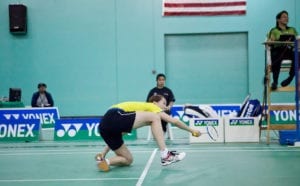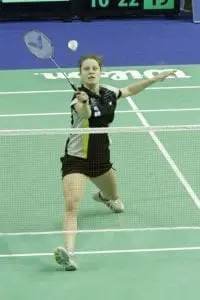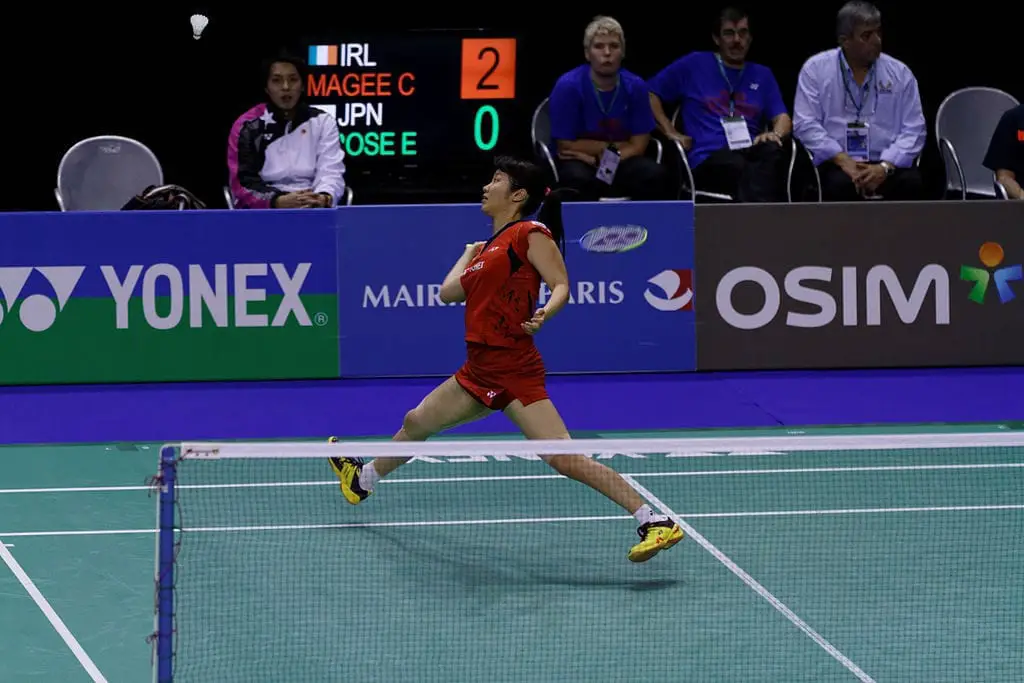Hi everybody and welcome to badminton tips and tricks #2. In this edition, we will be talking about some tactics you can use for both men’s and women’s singles to win your games. Most of the time, singles is the most strategic type of badminton. Once you reach advanced or higher level badminton, games will be more difficult, and the singles player to win would have to be the one with the most strategic play.
Here are a few tips and tactics for playing badminton, singles edition.
Moving Your Opponent
Moving your opponent is the most basic strategy in all badminton, even doubles. Just think about it, is it easier to hit the shot back if it’s in the same spot or more comfortable to hit shots that are always different?
Another reason for moving your opponent is so practical is because they’ll eventually run out of energy. Also since it’s singles gameplay, players will have to cover the whole court effectively making them tired even faster. Now that you know why moving your opponent is so important, let’s get into ways that you can do it.
Play variations! Badminton can get really boring if you play the same thing all the time. Try to perform different types of shots against your opponents. One example is to push the shot to the back and then hit it to the front, and you can also combine this with hitting side to side. The critical point is to change it up as much as possible.
Knowing this is an excellent start to formulating more advanced strategies. For now, let’s jump into some defence tactics for singles.
Singles Defending Tactics
Unlike doubles, singles defence is less about being able to block high powered smashes but more about being able to return shots without the opponent killing it. The top things to consider while defending is footwork, shuttle control, and reaction time.
The first thing to work on while defending is footwork. If your opponent is attacking you, they’ll likely be trying to move you around. Without proper footwork, you’ll be quickly put off balance and unable to return the shot. Try to stay relaxed and keep your center of gravity low. Staying relaxed will keep you from stiffening and staying low to the ground will allow you to move faster. Along with general footwork speed, you will do very well with defence, provided if you have the other parts as well. If you want some tips on general footwork things, check out Badminton Drills and Exercises for Improving Footwork and/or Badminton Tips and Tricks #1.

The next part after footwork is shuttle control. This is your ability to return the shuttle in ways that can cut off your opponent’s attack or make it more difficult for your opponent to attack. Try to hit the shuttle in a way where your opponent has to move the most and in ways that you’ll cut off your opponent’s rhythm. For example, blocking cross court will make your opponent run more, if you suddenly change up your defence and drive block, your opponent may be running too fast towards the front; these are just a few examples. Often times, a smash could go really fast, so it definitely takes some practice to block it without the shot being too high.
Continuing with shuttle control, the next few tips will be about lifts and what to play at the backcourt. First thing is about lifts as well as clears. Make your lifts and clears as far back and high as possible because this will give you way more time to recover and prepare for offensive shots like smashes. If you make lifts and clears flat, the opponent can smash it earlier as well as faster making it a lot harder to defend. The optimal position when in defence is stable and ready to react. If you’re pushed to the back, often times you want to play a fast drop. From the idea of giving yourself as much time as possible, playing a fast drop will make sure the opponent’s net shot comes further away from the net.
One thing to note is that at the backcourt, clearing may not be the optimal shot just because you have to play the shot closer to the ground which means less power. This less power translates into a clear that can potentially only reach the middle of the court in which the opponent can smash it down. Don’t try to win the rally off of your defence, patience is vital.
The final part is reacting to the shuttle. Just like your footwork, remain calm and just focus on getting to the shuttle. Don’t try to think about where you’re opponent will hit, just realize he or she can hit anywhere and react according to where the shuttle is going. Of course, if you have excellent anticipation, you can make it a lot easier to get to the shuttle but beware, when a player is in the attacking situation, that’s when he or she can play lots of deceptions.
Singles Attacking Tactics
Now that you’ve read the defence tactics for singles, you’ve probably gained lots of hints on how to attack in singles. Before you start attacking, there are a few things specific to singles. Smashing right away is not always the best option. It uses lots of energy, and lots of players are already prepared to block the smash. You should smash once you’ve crippled the opponent’s footwork a little. Let me show you ways that you can do that.
The time when you want to smash is when your opponent plays a bad clear or lift which is a result of footwork being scrambled. The most common ways to do this is by playing really tight net shots or push shotting. You can do this right off of your opponent’s serve if their service is weak or just test your opponent by playing a variety of shots and wait for them to make a mistake or when you see an opportunity to attack.
Once you’re in attacking position, your general pattern is straight or cross smash and then cross or straight net kill respectively, push shot or net shot at the front. If your opponent’s block is too high, generally you want to net kill it and end the rally. If the block is okay, try to play different things. Approach the shot like a net kill and then perform a net shot or flick your wrist at the last second to push it forward. These types of deceptions will break your opponent’s footwork even more, causing them to make mistakes or give you the perfect opportunity to end the rally with a smash or net kill.
it forward. These types of deceptions will break your opponent’s footwork even more, causing them to make mistakes or give you the perfect opportunity to end the rally with a smash or net kill.
Although the smash net kill pattern is going to extremely common, be prepared for variations. If you smash inaccurately and don’t have the angle or speed, your opponent can do things like drive block and cross block causing you to run more or have your rhythm broken. These things can completely break your attack if you’re not careful.
Also, note that there are lots of variations you can play too. Slice drops, body smashes (especially effective against tall players), and even clears can be performed at the back. You can play things cross or straight but just remember, cross court shots are slower than straight shots. Play as much variation as you can to force your opponent to use all of their energy.
Restricting Movement Tactic
I talked about how you should try to hit the shuttle to different places everytime you hit a shot to move your opponent right? It’s not entirely true.
Once you get to a very advanced level of playing, hitting to the same spot can be very useful if you can capitalize on mistakes or quickly change the pace of the game. Let’s say you continuously clear straight to your opponent. Your opponent is going to get used to that, and he’s going to subconsciously be closer to the back of the court and closer to the side your hitting when he attempts to return to the middle. When this happens, you can suddenly accelerate the pace of the game from the slow pace of clearing to a quick drop shot and cause your opponent to either not be able to return the shuttle or return the shuttle badly. Then you get into an attacking position and win the rally.
The main thing about this tactic is that it’s challenging to know if you’re opponent is positioned closer to wherever you would like them to position. If you don’t consider that they’re ready for you to change the pace of the game, then you will lose the point since you’re not prepared for them to return your shot. It takes lots of experience to know if you’re strategy is working or not.
Another thing we have to consider is that, what if your opponents are doing the exact same thing? If you’re opponent suddenly changes the pace, and you’re not ready, you’ll also lose the point. That’s what makes badminton so interesting; against tough opponents, you never know what they’re going to do so badminton sometimes becomes a sport of pure reaction and speed.
Conclusion – Checkmate Your Opponents
Hopefully, these tactics have taught you a lot. You should be able to take these skills right into your games provided you have good foundations. If you were looking for something that teaches you a little more about basics such as holding a racket, footwork, and/or basic shots, then definitely check out other articles on my site!
For now, if you have any questions or comments, please feel free to leave them down below. Stay tuned for the next articles, hint, it’s in pairs, and have a great day!


Lol my specialty used to be the quick drop shot.worked about 90 percent of the time. Love catching my oppenant off guard. It is almos like a game of chess the best stratgy wins. Already looking forward to your next article you hinted on pairs….i been trying to get the spouse to play doubles
Yes! I use drops way more than I used to before. I used to be a player who would try to smash as much as possible to win and it was working, until other people’s defense got better. In which I practiced drops a lot and now it’s a deadly weapon in my arsenal. Thanks for your comment!
Hello Kevin,
it has been years since I played badminton, but the one thing I remember being taught right from the start was to run my opponent to death as much as possible.
I am not so tall so it was challenging for me to jump high to hit those big smashes, but boy I could move fast, so this was my ace.
That was 35 years ago and now my badminton days are well past me, but your advice is as good today as it was all those years ago.
I often watch badminton on TV and wish i could get in there!
It’s nice to see your post, which I found as a member of Wealthy Affiliate.
Good work!
Tim
It’s great that you learned that strategy right when you started. Most people don’t learn that until way later. Fortunately, it’s not a difficult strategy to learn.
One of the key points about badminton actually is that you don’t have to be that tall. Sure, you might not be able to smash steeply at the back of the court, but if you manage to force your opponents to make a bad lift, you can capitalize on it.
You can check out my post on how to improve your smash.
very informative kevin.
Singles Defending Tactics is awesome
Thank you
Thank you! I’m glad you found the content useful.
My coach will always tell me run him down like he has not eaten for months. Then he will shout, KEEP HIM RUNNING UP AND DOWN TILL HE IS EXHAUSTED.
Yes, making your opponent run as much as possible is the ultimate strategy for singles as long as you are stronger mentally and physically. Your coach is spot on with that advice!